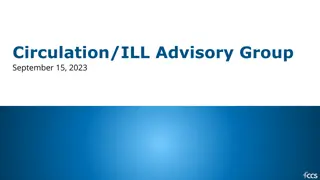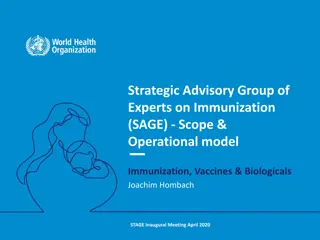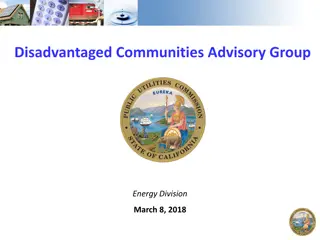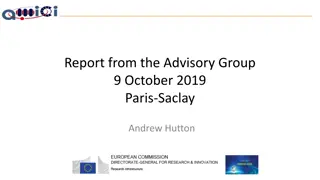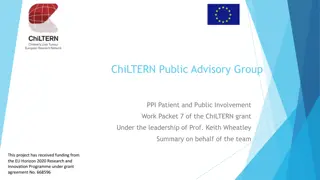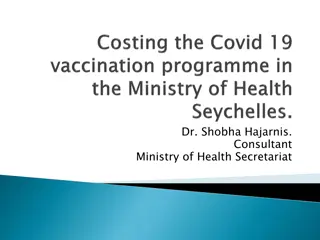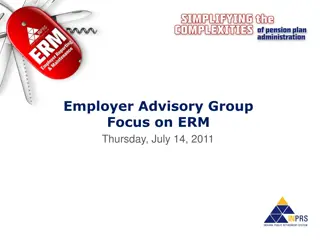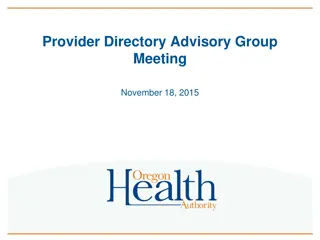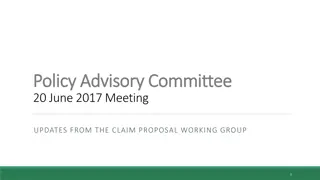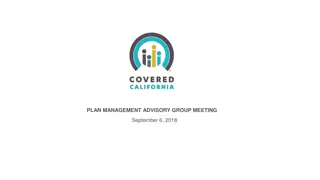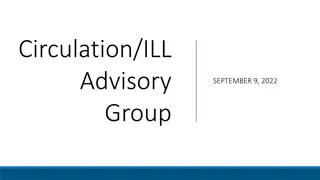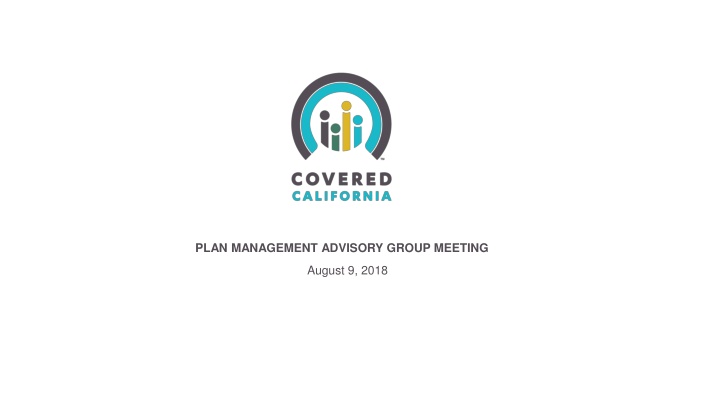
Plan Management Advisory Group Meeting Highlights August 9, 2018
"Explore updates from the Plan Management Advisory Group meeting on August 9, 2018, covering discussions on 2019 rates and offerings, Covered California insights, and more."
Download Presentation

Please find below an Image/Link to download the presentation.
The content on the website is provided AS IS for your information and personal use only. It may not be sold, licensed, or shared on other websites without obtaining consent from the author. If you encounter any issues during the download, it is possible that the publisher has removed the file from their server.
You are allowed to download the files provided on this website for personal or commercial use, subject to the condition that they are used lawfully. All files are the property of their respective owners.
The content on the website is provided AS IS for your information and personal use only. It may not be sold, licensed, or shared on other websites without obtaining consent from the author.
E N D
Presentation Transcript
PLAN MANAGEMENT ADVISORY GROUP MEETING August 9, 2018
WELCOME AND AGENDA REVIEW ROB SPECTOR, CHAIR PLAN MANAGEMENT ADVISORY GROUP 1
AGENDA AGENDA Plan Management and Delivery System Reform Advisory Group Meeting and Webinar Thursday, August 9, 2018, 10:30 a.m. to 12:30 p.m. August Agenda Items Suggested Time I. Welcome and Agenda Review 2019 Rates and Offerings 10:30 - 10:35 (5 min.) II. 10:35 - 10:50 (15 min.) III. Covered California Personnel & Strategy Update 10:50 - 11:20 (30 min.) IV. Dental Intern Research: Provider Quality and Risk Assessment 11:20 11:35 (15 min.) V. I. Plan Advisory Scope and Work Group Focus Areas Open Forum 11:35 12:20 (45 min.) 12:20 12:30 (10 min.) 2
2019 RATES AND OFFERINGS JAMES DEBENEDETTI, DIRECTOR PLAN MANAGEMENT DIVISION 3
2019 RATES AND OFFERINGS UPDATE All 11 health insurance companies will return in 2019. 96 percent of consumers will be able to choose from two insurers or more and 82 percent of consumers will have three or more choices. Average weighted rate change is 8.7 percent if all enrollees renewed into the same plan. o Loss of individual mandate penalty caused issuers to add between 2.5 and 6 percentage points to the rate increase, with an average of 3.5 percent, due to concerns that the penalty removal will lead to a less healthy/more costly consumer pool. o Federal suspension of the annual health insurer tax helped lower rates by approximately 1.6 percent. Tax is scheduled to return in 2020. o The average rate change for consumers who shop and switch to the lowest-cost plan in the same metal tier is -0.7 percent. Many consumers can pay the same rate they do now in 2018, or a little less. 4
2019 RATES AND OFFERINGS Over the past five years, Covered California has held average annual rate changes for unsubsidized consumers to an estimated average of 7.9 percent and 3.8 percent for subsidized consumers Premiums shown are the actual observed average premiums in Covered California administrative data for renewal and open-enrollment plan selections for plan years 2014 through 2018, and the percentage change is the change to the average observed premiums. Year over year, the average premiums shown may be influenced by changes in the population distributions (such as for region, age, metal tier, etc.). Average premiums for the off-exchange market as a whole could differ from the Covered California unsubsidized premiums to the extent that the off-exchange population and plan-choice profiles differ from the on-exchange, unsubsidized profile. Additionally, the 2018 unsubsidized premiums have been adjusted to remove the cost- sharing reduction surcharge in Silver, since off-exchange enrollees do not incur the surcharge, and Covered California encouraged its unsubsidized Silver enrollees to move off-exchange to avoid the surcharge in 2018. For coverage year 2019 premiums, this chart shows an estimate of what premiums would be if all consumers enrolled in their same 2018 plan for 2019. The chart applies the global weighted Covered California average increase of 8.7 percent to produce the estimated average unsubsidized premium, which is an estimate of what off-exchange enrollees may pay in 2019 (the actual 2019 amount will depend on enrollee take-up and plan choice during renewal and open enrollment). 5
LOOKING FORWARD TO 2020 Health Equity Ensuring the Quality Improvement agenda comprehensively considers health equity, which may include elements beyond the clinical setting, such as social determinants of health. Benefit Designs Copay only plan Possibility of regional pilots for Value Based Insurance Design (VBID) Continue to evaluate the potential for funded HSAs 2020 Certification Process 2020 - 2022 QHP and QDP Contracts 6
COVERED CALIFORNIA PERSONNEL & STRATEGY UPDATE TERRI CONVEY, DIRECTOR SALES AND OUTREACH DIVISION JAMES DEBENEDETTI, DIRECTOR PLAN MANAGEMENT DIVISION TAYLOR PRIESTLEY, HEALTH EQUITY OFFICE PLAN MANAGEMENT DIVISION 7
OUTREACH AND SALES DIVISION We work with The team 60Associates Programs 13,867 Certified Insurance Agents 1,014 Navigators 1,615 Certified Application Counselors 591Plan based enrollers 23Medi-Cal enrollers Field services Distribution services Navigator Program Covered California for Small Business 8
APPROACH TO 0E6 Stay on message - Power of progress - Worst uninsured rate in nation to <4% uninsured - Real people stories 46% of consumers enrolled with in-person assister Focus on what s working - Strong partners and advocates - In-person assistance - Storefront program - Help On Demand Innovate & Improve - CalHEERS enhancements - Pilot programs - Medi-Cal to Covered.CA process improvement 9
PLAN MANAGEMENT UPDATES New Deputy Director: Jan Falzarano New Health Equity Officer: Taylor Priestley Will oversee a new unit focused on Quality, Population Health and Health Equity, Population Care. (Formerly Quality Team but being expanded based on Plan Management strategic direction.) This team will ensure health equity perspective and priorities to all elements of quality improvement and delivery system reform agenda 10
PLAN MANAGEMENT: CURRENT STRUCTURE James DeBenedetti Director Lance Lang Chief Medical Officer Jan Falzarano Deputy Director Issuer Engagement Pam Power Manager Contracts Elise Dickinson Manager Population Care Taylor Priestley Health Equity Officer Analytics and Informatics Kristi Downer Interim Lead Plan Managers are liaisons between Covered California and health and dental plan issuers, ensuring daily formal and informal communication and problem solving. Coordinate with other divisions, agencies and organizations related to health plan issue resolution. Attachment 7 & Quality Improvement Strategy (QIS), and other quality-related work. Health Equity (will be infused into new work agenda). Consumer decision making tools (i.e. provider directory). Engagement with external organizations related to delivery system improvement and population care. Assess and analyze health and dental plan data including premiums, service area, enrollment, networks and provider directory. Benefit design development. Market research and comparison of benefit designs, pricing, and enrollment. Health and dental issuer contract management for individual and CCSB markets. Certification Management for QHP and QDP, Individual and CCSB markets. Vendor contracts. Managing audit issues related to Plan Management. 11
PLAN MANAGEMENT UPDATES: HEALTH EQUITY Creating a new team combining Senior Quality Specialists and new positions dedicated to health equity and social determinants of health o Initial phase: revising existing roles and responsibilities o Future hiring for new positions based on health equity agenda Engaging in internal and external research and discussions to draft health equity agenda strategic plan 12
DENTAL RESEARCH: PROVIDER QUALITY AND RISK ASSESSMENT MURIEL LAMOIS, QUALITY ANALYST INTERN & MPH CANDIDATE EMILY POLK, QUALITY ANALYST INTERN & MPH CANDIDATE PLAN MANAGEMENT DIVISION 13
IDENTIFYING AND ENCOURAGING USE OF HIGH PERFORMING DENTAL PROVIDERS Muriel LaMois, Quality Analyst Intern 14
GOAL How can you meaningfully collect and utilize quality measurements to identify and encourage use of high-performing dental providers? And How can you encourage enrollee selection of a primary care dentist and promote the use of a dental home to establish long-term, regular, comprehensive dental care from a high performing provider 15
LIMITATIONS IN MEASURING QUALITY IN DENTAL CARE Lack of diagnostic codes Rely on utilization and claims data Difficult to assess appropriateness of care Quality assessment mainly focused on compliance Systems and requirements in place for safety and licensure Difficult to assess degrees of quality within compliant providers Patient satisfaction is highly subjective Most commonly reported method of quality measurement Can skew negative Lack of objective quality measures Dental Quality Alliance most commonly used set of measures Approved first set of measures for adult population in 2016, three quality measures 16
ENSURING NETWORK QUALITY How do you incentivizeor reward high-performing providers? Objective Quality Measures Move from fee-for- service to pay-for- performance Enable providers to focus on preventative care Promote use of high- performing providers 17
THE DENTAL HOME MODEL Key components of a dental home: Access to care Quality of care Coordination of care Continuous care Provision of preventive care, including risk assessment Ideally, dental home concept should reflect a team approach that includes dental hygienists, primary care health professionals, community-based health providers, and families 18
CURRENT DENTAL HOME INITIATIVES Pilots showing impact in improving utilization and cost savings: Initiatives in 9 states and the Department of Health and Human Services DentaQuest s TennCare: 100% enrollees are assigned to a patient-centered dental home Members able to get routine appointment 8 days sooner; emergency care 11 hours earlier Program has saved Tennessee $27.5 million in Medicaid costs Other dental home initiatives: The ADA s Community Dental Health Coordinator (CDHC) Pilot Virtual Dental Homes Most focus on connecting low-income women and children to dental care 19
Barriers Continuous / Preventative Care Coordination of Care Patient Perspective Fear of dentist Low value of preventative services Potential for cost savings Reconciling both business models Dentists as part of the patient s coordinated care team Referrals between medical and dental Virtual Dental Homes Increased access to screenings and cleanings Mixed results on patient follow up for additional care No efficient way to share data Non-compatible EHR systems Cost prohibitive Diagnostic codes Incentivizing Preventative Care Feasibility as a business model Quality measures, pay for performance 20
HOW CAN COVERED CALIFORNIA HELP Better quality measures Standardized quality measures Consider cost of implementation Improve system integration Emphasize importance of integration Motivate engagement, inter-professional training Increase outreach Preventative care ad campaign Permission around provider outreach to new members Risk Assessment 21
DENTAL RISK ASSESSMENT: IDENTIFYING AND MANAGING AT-RISK ENROLLEES Emily Polk, Quality Analyst Intern Plan Management Division 22
PROJECT GOALS Inform Covered California dental quality agenda, focusing on: What are the existing definitions for at-risk enrollees ? What are the current ways issuers identify and proactively manage at-risk enrollees? What are current methods to identify member health status including chronic conditions? Where is this field heading? 23
WHAT DO WE MEAN BY AT RISK ENROLLEES? The QDP Issuer Model Contract defines at risk enrollees as: Enrollees with existing and newly diagnosed need for dental treatment and those who are most likely to benefit from well- coordinated care 24
WHY DO WE CARE ABOUT RISK? Oral health impacts general health, and vice versa o Smokers, pregnant women, and those with diabetes and other chronic and acute conditions are at increased risk. o Oral diseases and disorders affect health and well-being throughout life. Identifying and managing those who are at-risk for needing dental care not only improves member oral health but improves general health as well Unmet need: o 23% of children1 and 26% of adults2 have untreated tooth decay o Disparities by race/ethnicity and income Ultimately, our goal is to prevent disease and improve enrollee oral and general health 1) https://www.nidcr.nih.gov/research/data-statistics/dental-caries/adults 2) https://www.nidcr.nih.gov/research/data-statistics/dental-caries/children 25
DENTAL RISK IS MEASURED AT THREE LEVELS Plan level: Analysis of claims/encounter data Provider level: Caries Risk Assessment or other clinical risk assessment At each level, how can enrollee health be factored in to risk assessment? Enrollee level: Self-assessment through Oral Health Risk Assessment 26
KEY OPPORTUNITIES TO IMPROVE RISK ASSESSMENT AT EACH LEVEL Enrollee level assessment: Self-assessment through Oral Health Risk Assessment Opportunities Barriers Collecting OHRA results to target member outreach based on risk Covered California directing members to complete Oral Health Risk Assessment tools after dental enrollment Low incentive for enrollee to use complete assessment tool Does not replace clinical assessment 27
KEY OPPORTUNITIES TO IMPROVE RISK ASSESSMENT AT EACH LEVEL Provider level assessment: Caries Risk Assessment or other clinical risk assessment Barriers Opportunities Inconsistent tools Dental education Organizational Culture Promotion of a standardized Caries Risk Assessment tool Universal reimbursement for Caries Risk Assessment Enhanced benefit package based on level of risk 28
KEY OPPORTUNITIES TO IMPROVE RISK ASSESSMENT AT EACH LEVEL Plan level assessment: Analysis of risk based on claims/encounter data Barriers Opportunities Incomplete data received by plans Lack of diagnostic codes Lack of medical/dental integration Integration between health and dental plan data to identify high-risk members and target outreach Supporting the movement towards requiring diagnostic codes 29
NEXT STEPS: DENTAL TECHNICAL WORKGROUP DISCUSSIONS Potential Standardization o Definitions o Risk Assessment Tools o Quality and Performance Measurement Outreach and Education Opportunities o Availability and importance of no-cost preventive and diagnostic care o Importance of dental care for members with certain health conditions or risk factors o Importance of completing health risk assessments o How to choose a dentist Medical and Dental Integration Opportunities o Enhanced Benefit Design o Information Sharing o Care Coordination All discussions must include consideration of legal and technical challenges, cost and administrative burden to plans and providers, and consumer impacts. 30
PLAN ADVISORY SCOPE AND WORK GROUP FOCUS AREAS ROB SPECTOR, CHAIR PLAN MANAGEMENT ADVISORY GROUP 31
ADDRESSING ADDITIONAL TOPICS/PROGRAMS RELATED TO PLAN MANAGEMENT By leveraging work groups, several topics / programs could be addressed through the Plan Advisory model similar to the Benefit Design Work Group Advisory Group Plan Management & Delivery System Reform Working sessions to create a roll up your sleeves environment for stakeholder collaboration Work Group: Benefit Design Work Group: TBD Report out to the Plan Management & Delivery System Reform Advisory Group Work group composition would vary and not all would be staffed by Plan Management 32
POTENTIAL DOMAINS FOR WORK GROUPS OR ADVISORY TOPICS Plan Management & Delivery System Reform Advisory Group Marketing, Sales & Outreach Advisory Group* Health Equity & Quality Access and Cost of Care Benefit Design* Dental* CCSB* *Existing / Previous Advisory Group PMD will follow up with a survey through our stakeholder distribution list. To be added please contact Gina.Uybungco@covered.ca.gov 33
ACCESS AND COST OF HEALTH CARE WORKGROUP What Are We Solving For Addressing certain market wide issues & opportunities Leveraging this forum stakeholders to work together to address market wide opportunities to improve access and lowering costs How Would It Function Working group of Plan Management Advisory stakeholders Identifying actionable insights from the data Brainstorming and vetting solutions Reporting back through Plan Mngt Advisory Reporting from EAS 34
WHAT THE REPORT BACK TO PLAN MANAGEMENT COULD LOOK LIKE FOR ACCESS AND COST OF HEALTH CARE WORKGROUP Access & Cost Opportunity (from data) X% of children are below benchmarks for utilizing dental or vision services Actionable Insights (from research, stakeholder experience & clicking into the data) Low awareness of covered services More prevalent in [metal tier, region, demographic, etc] Ideas on How to Address (from stakeholder brainstorming / vetting) Produce standard messaging / campaign on accessing dental services pushed through community partners, QHPs, and CC marketing Consider partnering with [external collation / association] TBD Illustrative Example 35
OPEN FORUM AND NEXT STEPS ROB SPECTOR, CHAIR PLAN MANAGEMENT ADVISORY GROUP 36
OPEN FORUM ITEMS Benefit Design Work Group will likely start in September. If interested email Allie.Mangiaracino@covered.ca.gov. New C-Section Consumer Resource: My Birth Matters is designed to educate women about the overuse of C-sections and encourage them to engage with their care team to reduce chances of having an avoidable C-section. It is aligned with QHP maternal safety work. Please spread the work through your organizations! o More information: https://www.cmqcc.org/news/my-birth-matters-c-section-consumer- education-campaign-launches. 37

